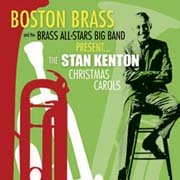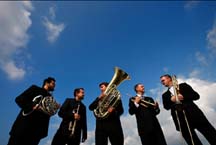|
|
||||||||||||||||||
Boston Brass & All-Stars Big Band
|
|
|
|
Boston Brass & All-Stars
Big Band
Boston Brass and Big Band swing holiday
jazz
By Tom Ineck
LINCOLN, Neb.—Classical brass ensembles
are no strangers to the Christmas holiday repertoire, but when the
Boston Brass is augmented by the Brass All-Stars Big Band, the result is
especially, festive, swinging and
In their final performance of the
“Christmas Bells Are Swingin’” tour, the musicians seemed in good humor
despite the weather and a two-set song list that seldom varied from the
program. Many of the seasonal favorites were first arranged by Ralph
Carmichael for the Stan Kenton band in 1961, but some received updated
treatments by members of the brass ensemble.
While remaining faithful to the melody
and the mood, Kenton’s arrangement of “Joy to the World” ended in a
trumpet high note that got everyone’s attention. Tuba virtuoso Andrew
Hitz worked hard on Carmichael’s “God Rest Ye Merry Gentlemen,” the band
swung in waltz time on “We Three Kings of Orient Are,” and trumpeter
Rich Kelley took the lead on “Angels We Have Heard on High,” and again
on a Latin treatment of “Santa Claus is Coming to Town,” where he was
strongly accompanied by tuba, piano and drums.
French horn player J.D. Shaw also
contributed several arrangements, including appropriately leaping takes
on three dances from Tchaikovsky’s “Nutcracker,” performed by the brass
quintet and prominently featuring Jose Sibaja doubling on piccolo
trumpet and flugelhorn and Lance LaDuke on euphonium. Shaw’s “Jingle
Bells Forever” was done Sousa-style with drums added. The entire band
returned to close the first half with Carmichael’s arrangement of “The
Twelve Days of Christmas.”
Comic antics included pianist David
Cutler’s use of Ping-Pong balls to deaden the strings on a variation of
“O Christmas Tree.” Trombonist Lance LaDuke performed his comic
composition “Wonderful Time of the Year” on ukulele, Cutler uncorked a
twisted version of “O Come All Ye Faithful” that combined elements of
rock and jazz in a style reminiscent of Frank Zappa, and the band ended
the concert with a take on “Greensleeves” described as “loud, angry and
violent.”
Richardson quartet weaves jazz tapestry
By Jesse Starita
KANSAS CITY, Mo.—Jazz
has a unique ability to weave together the lives of its sundry
performers into a single fabric. As an art form, it’s inclusive yet
selective, accepting but arduous. Those who make it—or those who
aspire—to the music’s summit, approach it from every conceivable
Although Richardson,
still just 30, left his native Kansas City for New York nine years ago,
the blues and swing of his roots are infused with a serene,
introspective timbre. Long steady whispers give way to a molten chute of
breakneck, buoyant phrases, like an idle horse that suddenly bolts into
action when kicked by its rider. On this particular Saturday, veteran
drummer Billy Hart expertly played the part of the rider, booting and
whipping his bass and snare; charging forward when necessary, retiring
where permitted. Bassist Tarus Mateen, who’s equally comfortable and
fluent working with hip-hop outfit Outkast or jazz vibraphonist Stefon
Harris, warmly inserted pithy and dexterous solos. The final thread
presented a wholly different kind of veteran: Israeli army vet and
pianist Shirmit Shoshan, whose looks, background and musical inclination
proved a fascinating contrast.
After a lengthy
intermission, Richardson re-introduced his band and called attention to
a woman seated alone at a candle-lit table. “I’d like to recognize
somebody in the audience who’s very special to me and that’s my mother,”
said Richardson, motioning his hands to the back of the room.
Coincidence or otherwise, after that moment, he sounded more at home, as
though freed from New York’s cosmopolitanism or Berklee’s lecture halls.
Well into the second
set, a slow blues churned from Mateen’s bass. At center stage, lips
sealed around the mouthpiece, Richardson found a dampened wail that he’d
eluded all night and—judging from the audience’s hoots and hollers—one
which they were eager to share with him. His quartet had, like jazz,
unwound their individual threads, entwined their strengths and wove into
the fabric a lasting strand rich in expression.
Editor’s Note:
At your request, we will mail a printed version
of the newsletter. The online newsletter also is available at this website
in pdf format for printing. Just click here: Newsletter

Performances
Articles 2010
Articles 2009
Articles 2008
Articles 2007
Articles 2006
Articles 2005
Articles 2004
Articles 2003
Articles 2002
January
2011
Performances
Concert reviews
 hilarious.
With 12 horns and a three-piece rhythm section, the music packs a
wallop, as demonstrated to an audience of nearly 1,800 brave souls who
ventured out on a frigid Dec. 11 night to the Lied Center for Performing
Arts.
hilarious.
With 12 horns and a three-piece rhythm section, the music packs a
wallop, as demonstrated to an audience of nearly 1,800 brave souls who
ventured out on a frigid Dec. 11 night to the Lied Center for Performing
Arts. The
five-piece ensemble also added drums to open the second set with a
brightly swinging Shaw arrangement of “Frosty the Snowman.” A trio of
traditional tunes arranged by Carmichael followed with “Good King
Wenceslas,” “Once in Royal David’s City” and “The Holly and the Ivy,”
replete with sleigh bells and whistling bandmates for the perfect
holiday effect. One of the most amazing performances of the evening was
solo trombone tour de force by LaDuke on “The Christmas Song.”
Accompanied only by Cutler on piano, he created devilishly difficult
variations on the familiar theme, wittily quoting “Tequila” and asking
the audience, “Do you folks know how hard this is?”
The
five-piece ensemble also added drums to open the second set with a
brightly swinging Shaw arrangement of “Frosty the Snowman.” A trio of
traditional tunes arranged by Carmichael followed with “Good King
Wenceslas,” “Once in Royal David’s City” and “The Holly and the Ivy,”
replete with sleigh bells and whistling bandmates for the perfect
holiday effect. One of the most amazing performances of the evening was
solo trombone tour de force by LaDuke on “The Christmas Song.”
Accompanied only by Cutler on piano, he created devilishly difficult
variations on the familiar theme, wittily quoting “Tequila” and asking
the audience, “Do you folks know how hard this is?”
![Alto saxophonist Logan Richardson at the Blue Room [Photo by Jesse Starita]](media/111Richardson1.jpg) angle. This is what keeps the music, the means to an end, fresh. On Nov.
20 at the Blue Room, alto saxophonist Logan Richardson and his quartet
elegantly braided their own scattered origins into that unique fabric.
angle. This is what keeps the music, the means to an end, fresh. On Nov.
20 at the Blue Room, alto saxophonist Logan Richardson and his quartet
elegantly braided their own scattered origins into that unique fabric.![Richardson and legendary drummer Billy Hart [Photo by Jesse Starita]](media/111Richardson2.jpg) Richardson
began with an amorous soliloquy, well-conceived and self-possessed. His
years at Berklee College of Music and The New School University quickly
revealed themselves in the flowing, amorphous compositions and
interpretations of standards. On Herbie Hancock’s “One Finger Snap,”
Richardson’s solo shimmered, the notes patiently resting in the air
until Hart’s whips and cracks set the direction. As one song cascaded
instantly to the next, my overworked right hand began to ache. Finally,
at the conclusion of the fourth number, Richardson introduced his
quartet and, pausing for a moment, asked them, “What was that last song
we played?” Quizzical looks were exchanged. “Stablemates,” responded
Shoshan.
Richardson
began with an amorous soliloquy, well-conceived and self-possessed. His
years at Berklee College of Music and The New School University quickly
revealed themselves in the flowing, amorphous compositions and
interpretations of standards. On Herbie Hancock’s “One Finger Snap,”
Richardson’s solo shimmered, the notes patiently resting in the air
until Hart’s whips and cracks set the direction. As one song cascaded
instantly to the next, my overworked right hand began to ache. Finally,
at the conclusion of the fourth number, Richardson introduced his
quartet and, pausing for a moment, asked them, “What was that last song
we played?” Quizzical looks were exchanged. “Stablemates,” responded
Shoshan.![Logan Richardson Quartet at the Blue Room [Photo by Jesse Starita]](media/111Richardson3.jpg) Richardson’s
laissez faire approach, not to be confused with dispassion, feels like
an emerging maxim for the young jazz artist, where complexity overtakes
form and formulas of eras past are recycled to create sounds that at
once drift, swirl and captivate.
Richardson’s
laissez faire approach, not to be confused with dispassion, feels like
an emerging maxim for the young jazz artist, where complexity overtakes
form and formulas of eras past are recycled to create sounds that at
once drift, swirl and captivate.